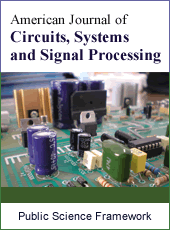American Journal of Circuits, Systems and Signal Processing
Articles Information
American Journal of Circuits, Systems and Signal Processing, Vol.4, No.4, Dec. 2018, Pub. Date: Dec. 23, 2018
Design of a High Linear CMOS Power Amplifier for Ultra-Wideband Applications Using the Derivative Superposition Method
Pages: 54-71 Views: 1934 Downloads: 610
[01]
Kamel Hussein Rahouma, Faculty of Engineering, Minia University, Minia, Egypt.
[02]
Omnia Mohammad, Faculty of Engineering, Minia University, Minia, Egypt.
[03]
Mahmoud Abdel Ghani, Faculty of Engineering, Minia University, Minia, Egypt.
The problem with the power amplifiers is that raising the gain and output power may affect the other amplifier factors specially in the frequency ultra-band. This paper presents a CMOS power amplifier (PA) for Ultra-Wideband (UWB) applications in 2.2 to 5 GHz using two stages of common source topology with derivative superposition (DS) method. Simulation results show an average power gain of 27.2 dB with an input 1dB compression point (1dB-CP) of -14.6 dBm at 3.2 GHz and an output 1dB compression point (1dB-CP) 12.9 dBm. With an input power of 83.8 mW, from a 1.8 V supply, power added efficiency (PAE) is 47.5% at 3.2 GHz with 50Ω load impedance and stability factor is 7.2 at 3.2GHz. The proposed design has been simulated using TSMC 0.18µm technology. The important parameters that define an RF Power Amplifier are: Output Power, Gain, Linearity, Stability, DC supply voltage, Efficiency, Ruggedness. The design results showed high power output without affecting the other amplifier factors. A comparison with the previous research has been done and the comparison is clearly in favor of the present design.
Ultra-Wideband (UWB), Power Amplifier (PA), Derivative Superposition (DS) Method, Common Source Power Amplifier
[01]
Behzad Razavi, Design of analog integrated circuits-Razavi, Chapter 2, 2000.
[02]
J. Rogers and, C. Plett, “Radio Frequency Integrated Circuit Design,” Artech House, Boston, London, 2003.
[03]
Hamed Mohamed Mohey El Deen Mosalam " Design Methodology for Wideband CMOS Power Amplifiers: Targeting Next Generation UWB and Quasi-Millimeter Wave Band Wireless Applications" Doctor Thesis submitted to Egypt-Japan University of Science and Technology (E-JUST), September 2016.
[04]
C. Lu, A.-V. Pham and M. Shaw, “A CMOS Power Amplifier for Full- Band UWB Transmitters,” in Proc. IEEE RFIC Symp., 2006, pp. 397-400.
[05]
T. H. Lee, The Design of CMOS Radio-Frequency Integrated Circuits, 2nd ed. New York: Cambridge Univ. Press, 2004.
[06]
S. Andersson, C. Svensson, and O. Drugge, “Wideband LNA for a Multistandard Wireless Receiver in 0.18um Process,” in Proc. European Solid-State Circuits Conf., 655-658, Sep. 2003.
[07]
Chris Bowick and others, “RF Circuit design”, 2nd edition, 2008, ch. 6.
[08]
Li Yilei, Han Kefeng, Yan Na., Tan Xi, and Min Hao, “Analysis and implementation of derivative superposition for a power amplifier driver,” Journal of Semiconductors, 2012, pp. 045002-1- 045002-8.
[09]
Sew-Kin Wong, Siti Maisurah, Mohd Nizam Osman, Fabian Kung and Jin-hui See, “High Efficiency CMOS Power Amplifier for 3 to 5 GHz Ultra-Wideband (UWB) Application,” in Proc. IEEE Transactions on Consumer Electronics, Vol. 55, No. 3, AUGUST 2009, pp. 1546-1550.
[10]
Porto Alegre "CMOS linear RF power amplifier with fully integrated power combining transformer" Master Thesis submitted to UIVERSIDADE FEDERAL DO RIO GRANDE DO SUL, August 2017.
[11]
Tuan Anh Vu, Tuan Pham Dinh, Duong Bach Gia" High-Efficiency High-Gain 2.4 GHz Class-B Power Amplifiers in 0.13 μm CMOS for Wireless Communications" VNU Journal of Science: Comp. Science & Com. Eng., Vol. 33, No. 1 (2017) 1-7.
[12]
S. Jose, H-J. Lee, D. Ha and S. S. Choi, “A Low-power CMOS Power Amplifier for Ultra wideband (UWB) Applications,” in Proc. IEEE International Symposium on Circuits and Systems, 2005, pp. 5111- 5114.
[13]
C. H. Han, W. W. Zhi and K. M. Gin, “A Low Power CMOS Full-Band UWB Power Amplifier Using Wideband RLC Matching Method,” in Proc. IEEE Electron Devices and Solid-State Circuit Conf, 2005, pp. 223-236.
[14]
R-L Wang, Y-K Su and C-H Liu; “3~5 GHz Cascoded UWB Power Amplifier,” in Proc. IEEE Asia Pacific Conference on Circuits and Systems, 2006, pp 367-369.
[15]
S.-K. Wong and F. Kung, “A WIMEDIA COMPLIANT CMOS RF POWER AMPLI-FIER FOR ULTRA-WIDEBAND (UWB) TRANSMITTER,” Progress In Electromagnetics Research, Vol. 112, 329{347, 2011.

ISSN Print: 2381-7194
ISSN Online: 2381-7208
Current Issue:
Vol. 6, Issue 1, March Submit a Manuscript Join Editorial Board Join Reviewer Team
ISSN Online: 2381-7208
Current Issue:
Vol. 6, Issue 1, March Submit a Manuscript Join Editorial Board Join Reviewer Team
| About This Journal |
| All Issues |
| Open Access |
| Indexing |
| Payment Information |
| Author Guidelines |
| Review Process |
| Publication Ethics |
| Editorial Board |
| Peer Reviewers |


